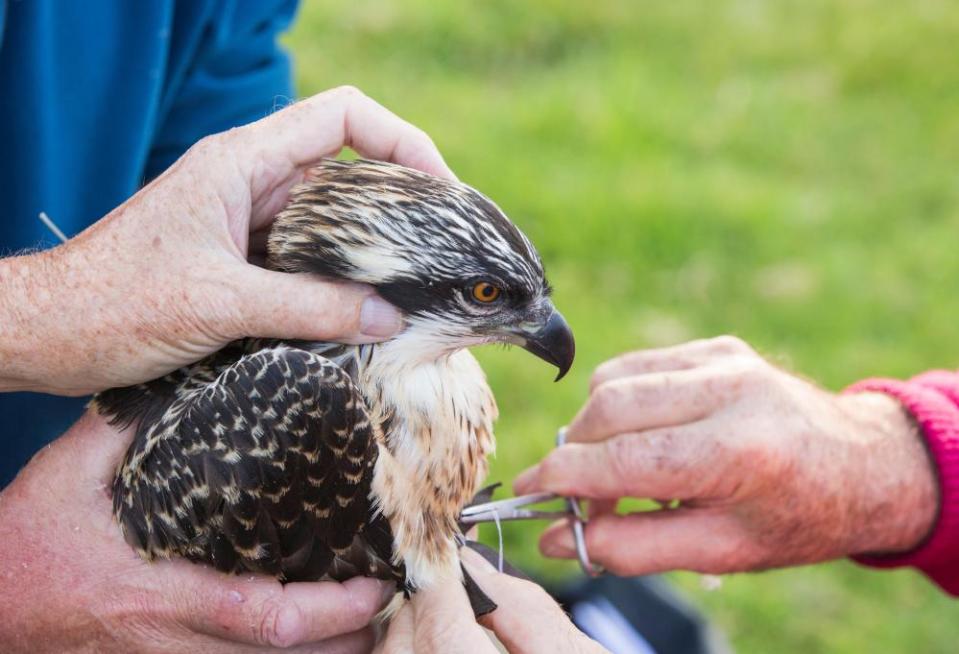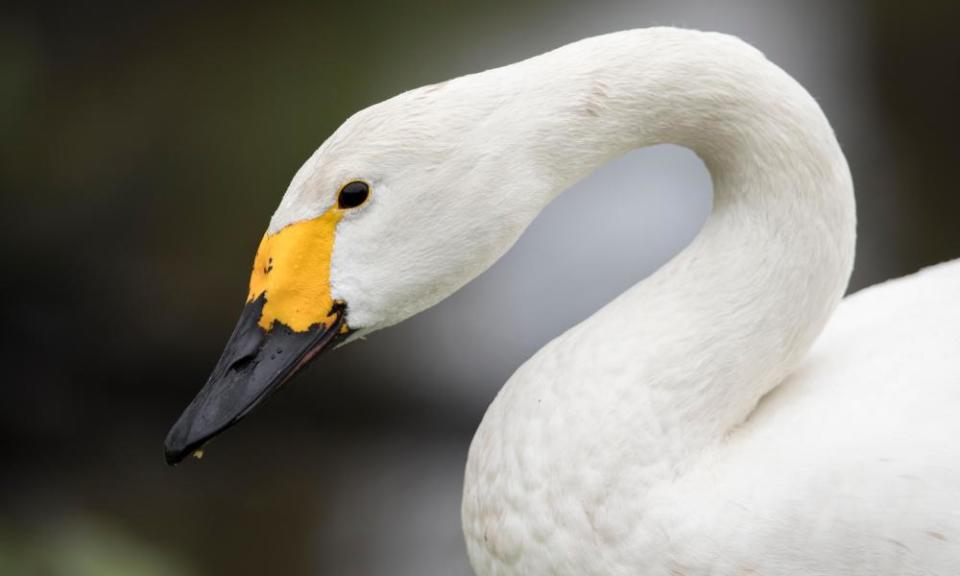'Human swan' to take flight on new mission to follow migrating ospreys
Sacha Dench is not one to sit still. Known to many as “the human swan” for her record-breaking journey tracking migrating swans in a motorised paraglider, the conservationist and adventurer is planning her next aerial mission: to follow ospreys migrating 7,000km across Europe and Africa.
“It’s really hard to get people to care about migratory species because they are not the responsibility of any one country,” says Dench, who founded Conservation Without Borders and was named as a UN ambassador for migratory species this year. “Birds often don’t fit within borders so they don’t sit in national action plans unless they breed there. But we need to think of conservation in terms of a species’ entire flyway or migratory track.”
It was in 2016 that Dench undertook the Flight of the Swans, flying 7,000km across 11 countries in a paramotor to track the migrating Bewick’s swan (Cygnus columbianus bewickii) across the tundra in the Russian Arctic to the UK.
Next year, as part of her three-year strategy as UN ambassador, she will take to the skies once again to follow ospreys migrating 7,000km across Europe and Africa. Every August, these birds of prey fly from their breeding grounds in Scotland, south to the Strait of Gibraltar and across the Sahara to Senegal, Guinea-Bissau and Ghana in west Africa, where they spend the winter.
In preparation for the four-month Flight of the Osprey expedition, Dench is speaking to British ambassadors in every country along the route. With help from scientists at Cardiff University, she is developing a protocol for aerial photo surveys of macroplastics, and will log manatees, humpback whales and other marine mammals she sees from her paramotor. As she flies, her motor turned off as much as possible as she catches thermals as ospreys do, her support team on the ground will sample water quality and test for pollutants, pesticides and microplastics, and assess the state of seagrass – an important habitat for the fish ospreys eat and also a great carbon store.
The osprey has bounced back from extinction in the late-19th century in areas of Britain and is found in many parts of the world but, according to the Roy Dennis Wildlife Foundation, 60% of birds in the UK die before breeding, partly because they get entangled in fishing nets and collide with power lines. Globally, they also face loss of habitat from mangrove deforestation. “Ospreys need sites to perch above the water when they are fishing so healthy mangroves are crucial,” says Dench, and their destruction “also causes mass siltation of the rivers so the birds can’t see the fish”.

Dench first took to the air in a paraglider in a quest to conquer her “debilitating” fear of flying after a frightening experience in a small plane. “It’s such simple technology and I could feel every single movement, so I felt very connected to the air. I could catch thermals like a bird. Learning to fly was an intense experience.” Then she saw someone put a motor on their back and realised that she could “take off anywhere and do anything. So, now I have an aircraft in the back of my car.”
When she discovered the paramotor, Dench, a biologist, was working for Wildfowl and Wetlands Trust (WWT). She started using it to take aerial photos as a way of assessing habitats. “Wetlands make so much more sense from the air because it’s possible to see how they connect and how they change with the tides – these photos helped to put wetlands on the map,” she says.
There was one magical moment when two swans flew alongside at my right wingtip
Sacha Dench
WWT scientists, who X-ray birds on their return to UK wetlands, had found that, for the past 30 years, one in three Bewick’s swans had shot in their bodies. “But the declining swan population was difficult to solve. The number of different problems in each of the 11 countries they fly through can be overwhelming,” says Dench, who kept looking at the map, imagining what their gruelling journeys might involve. “I wanted to bring that to life while engaging with key players, from hunting associations to power companies, and inspiring communities to help.”
As she followed the journey of eight GPS-tagged swans, Dench endured extreme cold and challenging flying conditions. But she remembers a particular highlight.
“There was one magical moment when two swans flew alongside at my right wingtip, surfing on the big vortex,” says Dench, who holds a Guinness World Record for being the first woman to cross the English Channel by paramotor. She certainly made an entrance every time she landed in remote communities to talk to hunters, farmers and schoolchildren, and promote the importance of protecting these birds.
“People would arrive from miles around to ask, ‘Where have you come from? Isn’t it dangerous?’; ‘How can I help?’ So this was an incredible way to introduce the swans – people won’t forget that encounter and it helps change the culture.”
One declining migratory species often indicates trouble somewhere along the flyway. As well as habitat loss threatening their survival (90% of UK wetlands have been lost in the past 100 years), some well-travelled Bewick’s swans are hunted – sometimes intentionally, for food, sometimes accidentally, mistaken for other swans that are not protected. Dench helped to create a group called Swan Champions to connect every hunting operator in the Russian Arctic. She says they simply didn’t realise that Bewick’s were endangered.
Related: The vultures aren't soaring over Africa – and that's bad news
“You can’t judge a culture from the outside, every country has a different story and by being a human swan I could share examples of how other people along the flyway are taking positive action, from the Nenets [people] of the Russian Arctic to England. It all adds up and makes a real difference.”
Power lines are a constant danger for migrating birds such as Bewick’s and ospreys, so Dench is excited that a new citizen-science app, e-faunalert, enables anyone to report bird collisions.
“Power lines are a big part of our renewable energy future but they must be clearly visible and installed away from bird migration hotspots,” she says. “The data from this app will help build a picture of where bird collisions are the biggest problem.”

Bewick’s swans live for 25 years so new data is slow to arrive, but the last count showed that the population is starting to grow. “The expedition can’t not have had an impact – we reframed the conversation and got people talking – that must have affected the wildlife,” says Dench, who once again will engage with local communities in Europe and Africa as she investigates the threats to ospreys and other migratory birds using the flyway.
“There’s a sense of urgency [to this next expedition] because some wetlands in west Africa won’t have water in just a couple of decades due to climate change. It will be fascinating to explore.”
Find more age of extinction coverage here, and follow biodiversity reporters Phoebe Weston and Patrick Greenfield on Twitter for all the latest news and features

 Yahoo News
Yahoo News 
